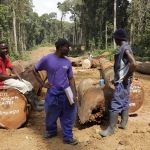US: Farmers Fear Coal Mining Will Sink Land
The 'longwall' method yields more, supporters of an Illinois plan say. But opponents say it will cause wide swaths of cropland to droop.
The nation's hunt for fuel soon may sweep below the lush fields of corn and soybeans here, and it could dramatically change the prairie landscape.
Two mining companies want to dig for coal under nearly half of Montgomery County. They plan to use a nontraditional but highly efficient process called "longwall" mining that will cause flat-as-a-dime land to sag like a burst souffle.
Longwall dispenses with any attempt to shore up the earth when coal is dug away as mine equipment eats through the substrata. The mines are meant to collapse. And when they do, wide swaths of cropland droop 5 or 6 feet. Roads, homes and utility connections will buckle and trees will die, wreaking havoc on farm drainage and perhaps wells.
The companies say that the inconvenience will be brief and that the law requires them to repair damage. Many farmers here, however, contend that's impossible and fear the changes will ruin their fields.
"A dollar bill doesn't fix the land after it's been totally changed forever," said Dale Miller, who farms 1,200 acres here. "I know my land like the back of my hand. I know what spots are a little too wet, what spots are a little too dry. Now they want to screw it up."
Miller is part of a passionate "not in my back-40" style resistance brewing here, even as the summer's soaring energy prices have triggered a headlong rush to exploit the nation's abundant coal reserves.
Longwall backlash is rubbing emotions raw in Montgomery County, south of Springfield, Ill., pitting rural residents against city dwellers and neighbors against neighbors. The mines promise to bring lots of good-paying jobs and billions of dollars in investment, and local officials and business interests see that as the remedy for the county's long economic funk.
The fears of farmers are simply unfounded, longwall backers say. "Some of the folks here think it's all the plagues in the Bible, but it's not," said Roger Dennison, president of Hillsboro Energy, which owns coal rights under 120,000 acres in the county. "We are obligated to return the land and the structures in the same or better condition than we found them, and we will."
Such assurances haven't swayed critics. The Montgomery County Farm Bureau and the Illinois Sierra Club have jumped on the anti-longwall bandwagon. A citizens group has filed a federal lawsuit seeking to block the mining technique.
Meanwhile, opponents have pressured the county board into placing an advisory referendum on the Nov. 7 ballot. Although it wouldn't be binding, an official of Alabama-based Drummond Coal, which owns 80,000 acres of county coal rights, said voter rejection could lead the firm to rethink plans to mine here and build local gasification plants to transform coal into diesel fuel. Hillsboro, an offshoot of West Virginia-based Colt Coal, says it will press ahead regardless.
Longwall is increasingly common in U.S. mines, including three operations in Illinois. Other longwall mines have engendered complaints, but state and industry experts say they have never seen anything like the protest in Montgomery County, where opponents insist that the environmental impact will be more acute because the topography tends to be much flatter.
The industry's attraction to longwall is obvious. It allows much more coal to be dug out than the traditional method of underground mining, known as "room and pillar."
Coal seams are part of the underground support structure of the earth. Remove the coal and the rock, and clay and dirt tumble down to fill the void. Localized surface cave-ins, known as subsidence, are common in communities built over old, poorly constructed mines.
Modern room-and-pillar mines are built to protect against that and to safeguard miners from cave-ins. They are laid out in a grid pattern that leaves thick pillars of coal in the ground to support the roof and keep the mine cavity intact.
Longwall mines, on the other hand, are designed to collapse. The longwall machine is a giant drum that shears off the face of a coal seam in series of 1,000-foot passes. Hydraulically supported steel shields protect the machinery and the miners who run it. Even critics of longwall mining acknowledge that the process is safer for miners.
The room and pillar technique forces miners to leave as much as half the coal in the ground. With longwall, they can take as much as 90%.
In the thick of the anti-longwall push is a group called Citizens Against Longwall Mining. Members say they would welcome mining if it were done only in room-and-pillar style. Drummond and Colt insist on longwall. It's a matter of economics and physics, they say.
What geologists call the Illinois coal basin is just that, a basin. Much of what has been mined during the last century was closer to the edge and surface. The Montgomery County mines would have to go much deeper, in some places 600 feet beneath the surface.
At 600 feet down, Dennison estimated, more than 70% of the coal would have to be left in the ground through room and pillar.
Dan Barkley, a subsidence expert with the Illinois Department of Natural Resources, said longwall had been used on and off in southern Illinois for decades without serious damage to agricultural productivity. "We can project the effects and make them define where drainage will be interrupted so they can plan for a fix ahead of time," he said.
When flat land as found in Montgomery County sags in the middle, it can act like a bathtub without a drain, leading to crop damage. Barkley said that made the restoration task harder, though not insurmountable.
Longwall opponents still fear for their land's long-term quality. Mark Bertolino, whose family began farming in the area in 1832 said, "The life expectancy of the mine is about 30 years, but what will we have 50 to 100 years from now?"
- 181 Food and Agriculture
- 183 Environment



